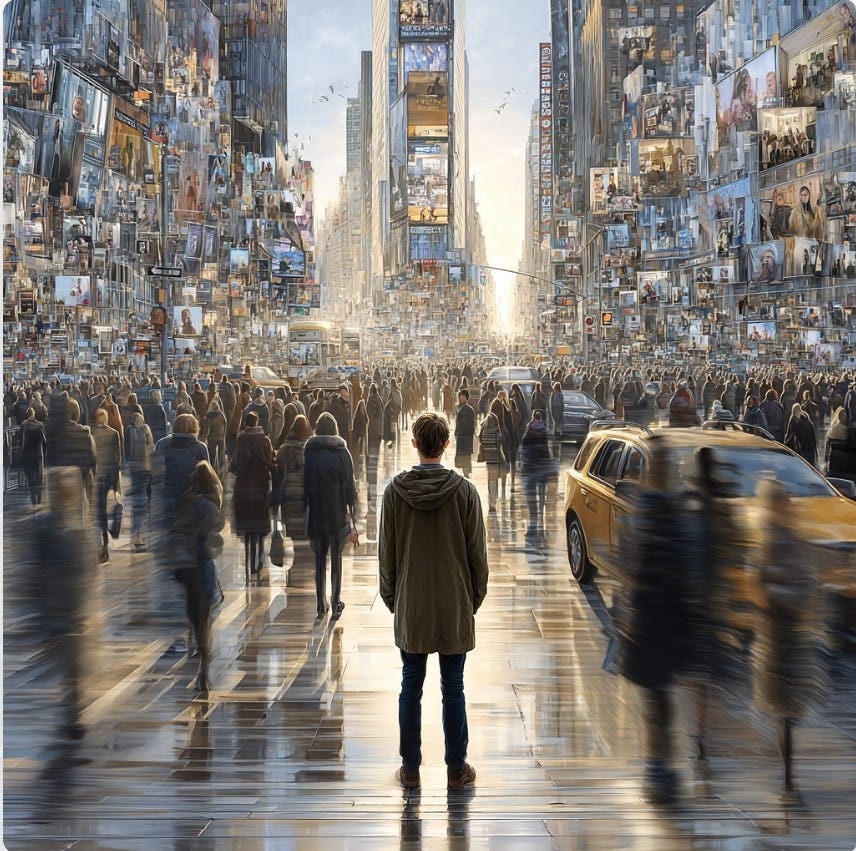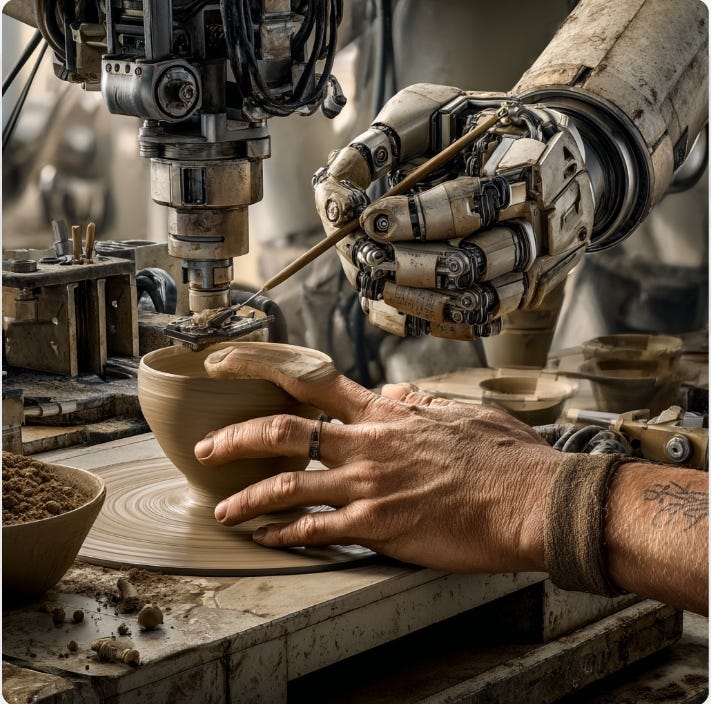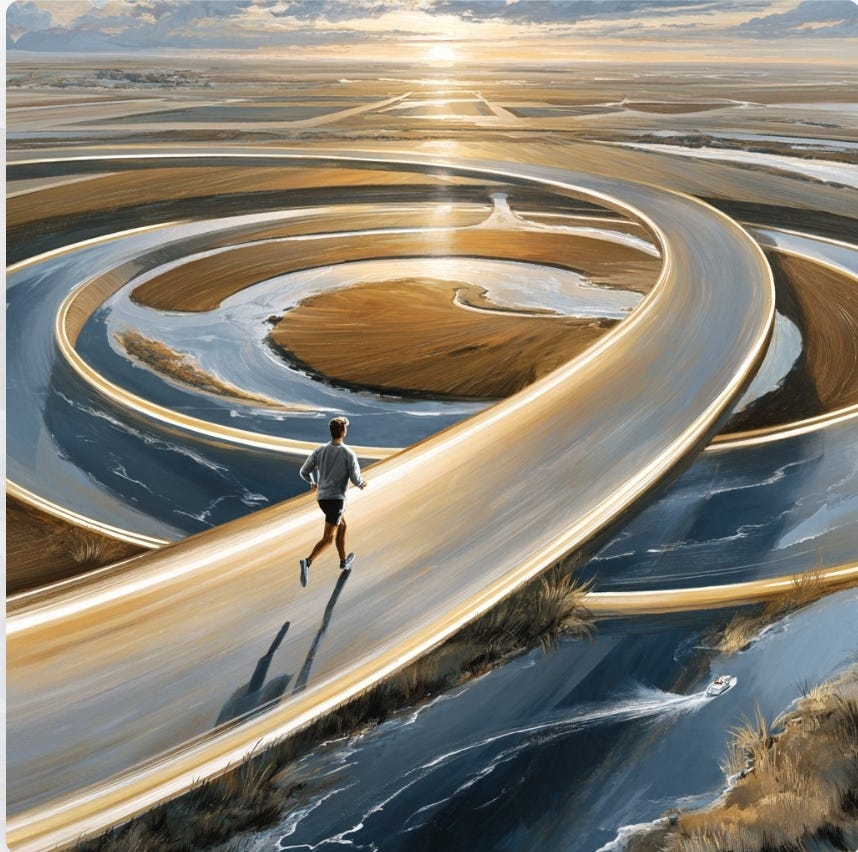Rethinking progress to build smarter, not faster
How slowing down helps us build with clarity, care, and meaning
Co-authored By Sam Illingworth and Juan Salas-Romer
I. The World That Forgot How to Pause
Why Founders Need to Slow Down to Speed Up
If you build, lead, or consult for a business, you already know the constant pressure to move fast. Every new tool, every AI breakthrough, every metric seems to whisper the same command to accelerate. Yet the next real advantage may not be speed, but attention.
Every generation tells itself that speed is progress. We build tools to move faster, communicate faster, decide faster. We treat friction as inefficiency and silence as waste. Yet the faster we go, the less we see.
Technology now accelerates thought itself. Artificial intelligence moves from input to output in fractions of a second, collapsing the space where meaning is made. In boardrooms and start-ups, the same pattern repeats. Decisions are optimized before they are understood.
Both of us have watched this pattern unfold from different vantage points.
Sam Illingworth, through
, studies how acceleration in technology reshapes culture and attention.Juan Salas-Romer, through , helps founders slow their minds long enough to think clearly and act deliberately.
What follows is a conversation across disciplines: a shared attempt to rediscover rhythm in a world that has mistaken motion for meaning.
II. The Ideology of Acceleration
(Sam Illingworth)
In 1995, Richard Barbrook and Andy Cameron published The Californian Ideology, describing Silicon Valley’s strange fusion of counterculture idealism and market fundamentalism.
It promised freedom through technology, creativity through disruption, and equality through connectivity. Yet its legacy has been a digital world defined by hierarchy, not harmony.
That ideology survives in the culture of artificial intelligence. We speak of frontier models and exponential growth as if acceleration were destiny. But progress measured only by speed becomes a race without a direction.
Acceleration creates blindness. The faster we build, the harder it is to ask why.
III. The Human Mirror
(Juan Salas-Romer)
Founders often live inside the same logic. They start with purpose, then inherit a system that rewards perpetual motion. Investors, tools, and trends whisper the same command: move faster. They measure momentum instead of meaning.
The result is what I call the founder’s fog. Work fills every hour, yet clarity fades. The company grows louder, not wiser.
Like an overtrained AI model, the human mind begins to misfire from overexposure to input. The cure is not more data. It is deliberate reflection.
When founders slow their pace, even briefly, they stop reacting to the machine of urgency. They start thinking again.
IV. The Philosophy of Slow
(Sam Illingworth)
Slowness is not an aesthetic. It is a discipline. It means resisting the instinct to answer before understanding, to design before considering consequence.
The speed of AI reveals our discomfort with limits. We crave constant output because silence feels like weakness. Yet all genuine insight comes from pause.
To move slowly is to recover agency. It allows space for care, ethics, and imagination—the very elements automation cannot reproduce.
Five questions guide this reflection:
What kind of intelligence are we building, and what kind are we neglecting?
Machines learn to predict patterns. Humans learn to assign meaning.Who benefits from acceleration, and who bears its cost?
Every breakthrough has unseen dependencies: labor, data, energy.If everything becomes automated, where does meaning live?
Friction is not waste. It is the birthplace of empathy and craft.Are we designing tools that expand awareness, or ones that replace it?
Technology should extend attention, not erase it.What does a responsible pace look like?
Progress without reflection is extraction. Design with care is its alternative.
These questions remind us that speed is not neutral. It shapes ethics, labor, and even perception. To slow down is not to oppose innovation but to restore depth to it.
V. The Practice of Thinking to Thrive
(Juan Salas-Romer)
Founders rarely struggle from lack of ambition. They struggle from lack of clarity.
The faster they move, the more they confuse motion with progress.
Reflection is not a luxury for them. It is a survival mechanism. When we slow the mind, the next decision often reveals itself.
I use five questions to reset the system, not as techniques, but as moments of self-supervision—the human version of retraining a model.
What is the real decision I am avoiding right now?
Overwhelm hides in indecision. Naming it restores energy.If I could only make progress on one thing this week, what would matter most?
Prioritization converts chaos into momentum.What would this look like if it were easy?
Complexity often hides fear. Simplicity invites movement.What do I know for sure, and what am I assuming?
Assumptions distort judgment. Reflection recalibrates.If I looked at my business as an investor or coach, what would I tell myself to do next?
Perspective restores rationality when emotion clouds it.
These questions work because they create friction. They force a pause inside the founder’s operating rhythm—the same kind of pause that Slow AI asks of technologists.
VI. Reclaiming Friction
(Sam Illingworth)
Friction is where learning happens. The early digital pioneers of the 1960s understood this. Community radio, local zines, and public access networks were born from resistance to centralization. They used technology to connect, not to conquer.
Friction gives texture to creativity. It slows the loop long enough for understanding to catch up to invention. Without it, we lose the moral rhythm that keeps innovation humane.
Our culture treats effortlessness as virtue. Yet anything worth building, art, code, or company, requires struggle. To design friction back into our systems is to design meaning back into our lives.
VII. The Human Algorithm
(Juan Salas-Romer)
Machines learn through iteration. Humans learn through reflection. Every founder runs a loop of feedback, failure, and refinement. The difference is that humans can choose their dataset. They can decide which stories to learn from and which to discard.
Critical thinking is the founder’s training data. It replaces reaction with reasoning and turns uncertainty into pattern recognition.
Artificial intelligence can process faster, but it cannot prioritize purpose. Human intelligence can. That is where slow thinking becomes a strategic advantage.
Speed without awareness scales problems. Reflection scales wisdom.
VIII. Reclaiming the Commons of Attention
(Sam Illingworth)
Barbrook and Cameron concluded their critique with a call for shared infrastructures, a digital common governed by participation rather than profit.
That vision matters again. If the twenty-first century is to remain human, we must treat attention as a shared resource. AI companies compete for it; social platforms harvest it; founders fight to reclaim it from distraction.
The real commons is not code or capital. It is consciousness. To protect that commons, we must build systems, technological and organizational, that make room for thought.
IX. Reflection as Strategy
Reflection is not retreat. It is recalibration. It converts reaction into design and speed into direction.
In Slow AI, reflection keeps technology ethical. In Build to Thrive, reflection keeps organizations sustainable. Both require the same rhythm: act, pause, understand, refine.
Speed produces scale. Reflection produces substance. One without the other is fragile.
X. The Counterculture of Clarity
The next generation of builders will not be defined by how fast they move, but by how clearly they think. They will design companies and systems that breathe, not just scale.
They will measure success not only in metrics, but in meaning.
The counterculture of our time will not arrive with noise or defiance. It will appear quietly, in the discipline of awareness. To slow down is not to fall behind. It is to move with rhythm, to create space for what matters most.
These are not questions about technology alone. They are questions about attention, responsibility, and care. To ask them is to bring depth back to creation itself. It is to pause long enough to see not only what we are making, but what it is making of us.
Sam Illingworth is the author of
, a project exploring the ethical and cultural dimensions of technology.Juan Salas-Romer is the founder of , a platform that helps entrepreneurs think critically, uncover opportunity, and design strategies that scale with clarity and purpose.









Thanks for writing this.
I recognised a lot of what used to happen in my own work when I read it. For a long time I operated inside the kind of environments you describe - speed equals progress, meetings are always rushed, etc etc. It became normal. It almost killed me.
But after quite a lot of navel gazing I can now see how that environment shaped what I thought success looked like: staying busy, 24/7, keeping momentum, faster faster faster. The only real result was that the quality of my work (and my life) suffered.
So these days…
… these days, after I started paying attention to how that all showed up, in my body, in what was achieved, in what felt bad, I often pause and ask myself a few simple questions to see what environment, or field (I call it that to make it less my fault and more about the bigger picture) I’m standing in:
What patterns or habits keep repeating around me? Rushed meetings, premature decisions etc etc
How does it feel when I move at this pace? More shallow breathing near deadlines, tension in my shoulders, or flow?
What gets rewarded here, and what gets overlooked? Do long hours or clear thinking get the praise. Is rest treated as something bad or an important part of the process?
When things get difficult, what tends to be protected first, and what gets dropped? Do I cut short reflection time to meet a target, or stop communicating clearly?
How am I defining success? Is being busy winning? Am I valuing output over outcomes?
If I wanted to stay in a healthier rhythm, what habits, lessons and process would I keep, and what would I let go?
These questions help me notice whether I’m still moving in alignment or not. I can now clearly see how unhealthy the field I used to work in was.
Which is what I think you guys were getting at.
Yes, the best way to make progress today is to FOCUS... everybody is looking for the next best automation tool and shortcut...
But, the shortcut is to build a solid foundation and move methodically.
It's not a popular strategy by Tiktok and IG short form video experts... but fundamentally true.